|
|
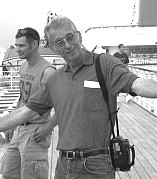 Fran Ridge |
|
|
 Fran Ridge |
ANOMALOUS
STRUCTURES IN PARACELSUS "C" ?
M118769870L / A
DISCOVERY REPORT
| M118769870L & Discovery Report | Tour of Paracelsus Area & NASA Cover-up | Imaged Again Jan 1, 2017 & NASA Silence |
|
20160515
Updated 20170901 Iincludes link to analysis paper
and flyovers (see bottom)
Fran Ridge; In 1962, Carl Sagan spoke on the possibility of discovering alien artifacts on the Moon stating that "forthcoming photographic reconnaissance of the moon from space vehicles - particularly of the back - might bear these possibilities in mind." ASU scientist, Paul Davies wrote: "Alien technology might also manifest itself in minings or quarrying activity, or even construction work." One of his papers mentioned "Geo-engineering structures": "If aliens used lunar material as a resource, they may have carried out mining or quarrying activities, or even have built large structures that could still be detected from photographic surveys. The main difficulty in identifying the scars of major geo-engineering work would be to distinguish them from naturally occurring features. A round open-cast mine, for example, may after some millions of years come to resemble an impact crater or collapsed lava tube at first sight, and only a careful analysis of the topography might reveal signs of artificiality. Excavations with more distinctive topography (spirals, rectangles, etc.) would be more conspicuous. Because we have no idea of the motives, capabilities or agenda of a very advanced alien technological community, we cannot guess what form of surface modification might ensue from an alien presence, even a fleeting one, on the moon. It therefore pays to be as broad as possible when seeking signs of past geo-engineering activity."There has been a lot of controversy for the last few decades about such structures on the Moon, but always a reasonable doubt. The objects in Paracelsus C could be an important discovery, but most likely the only way to settle the issue scientifically would be an amazing trip back to the Moon, but this time with an unmanned lunar rover. A manned mission would simply be too dangerous. You see, Paracelsus C lies on the BACK side. But I think Sagan would have given a thumbs up. In 2012 an interesting article appeared in UNIVERSE TODAY in April of 2012. "ASU Researchers Propose Looking for Ancient Alien Artifacts on the Moon". Two researchers at Arizona State University had made a rather controversial proposal: have the public and other researchers study the high-resolution photographs of the Moon already being taken by the Lunar Reconnaissance Orbiter (LRO), to look for anomalies that may possibly be evidence of artifacts leftover from previous alien visitation, possibly thousands of years ago. The theory is that if our solar system had been visited in the past, the Moon would have made an ideal base from which to study the Earth. The paper had just been published in the journal Acta Astronautica. Professor Paul Davies and research technician Robert Wagner admit that the chances of success were very small, but argue that the endeavor would be worth the minimal investment required. The photographs were already being taken on a regular basis by LRO. Any interesting finds could be examined by others including imaging professionals. Shape-recognizing software could also be used to help discern any possible artificial artifacts from natural ones. Apparently, what they didn't know or hadn't time to see, was they had already imaged a fascinating set of targets on the lunar Far Side. Nothing was mentioned about the possibility that such artifacts might have been placed there by early man and the Earth went through another extinction. But man or alien, the discovery and proof of a structure on the Moon would be the news of the century. 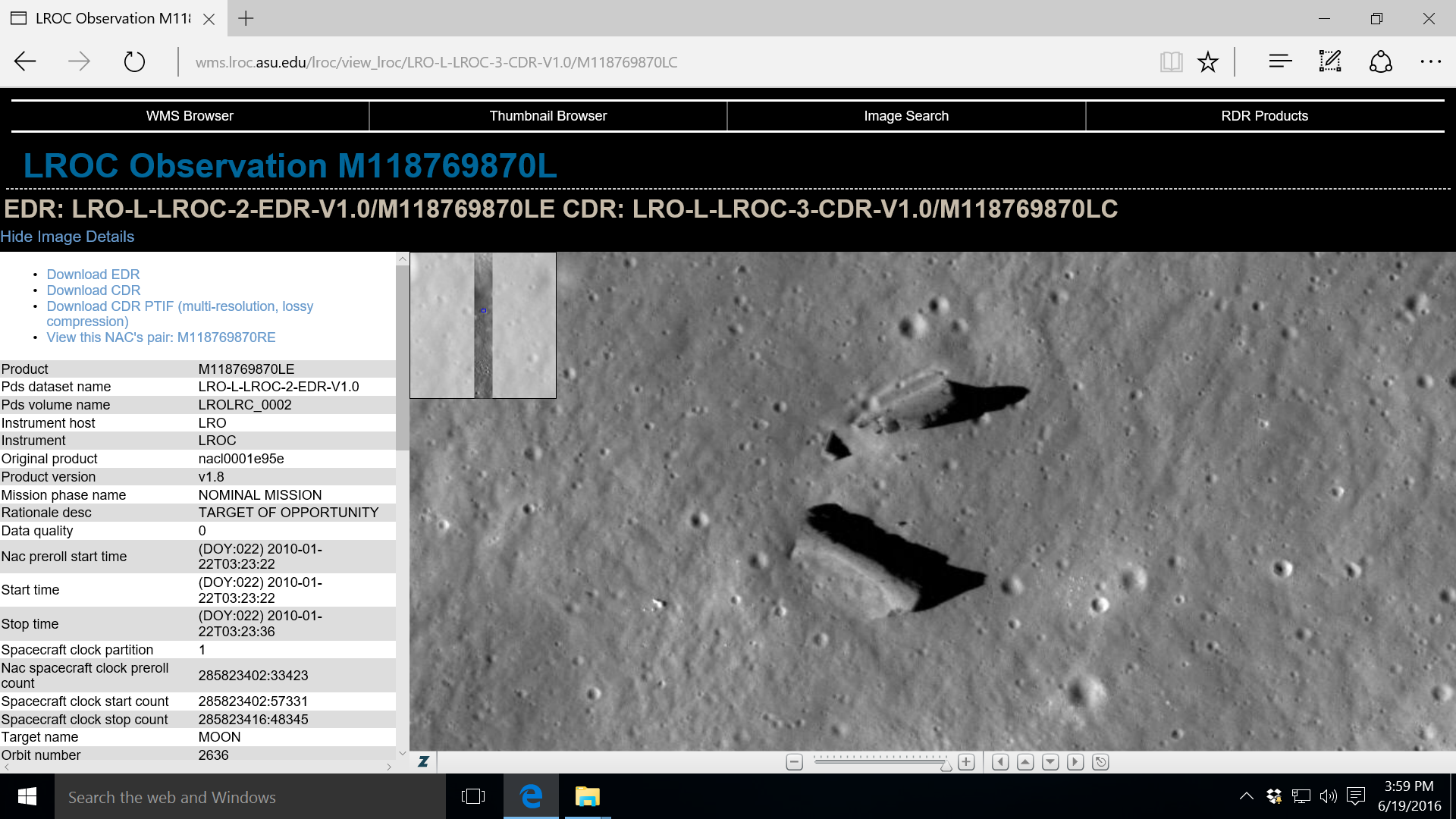 Figure 1 The "structures" on Lunar Reconnaissance Orbiter frame M118769870L Upper object: 15 m tall, 40 m long (130') Lower object: 10 m tall, 60m long (200') In late May I began compiling a report a few weeks after my colleague, Ananda Sirisena, sent an email with an attachment of images that looked like dark "towers" on the surface of the Moon. When I searched for images of towers on the Moon, not only did these "towers" show up, but "structures" and some NASA image sources were suggested in a non-NASA website. All of the attention seemed to be focused on "walls" & "towers" and all lumped into the same basket. The location of all of the objects were suppose to be in the area of Paracelsus, a crater system on the lunar Far Side. After quickly confirming the "structures" in an official LRO image (see Figure 1) I put the Lunascan Project verification team to work and began an investigation of the the most interesting features we're ever seen on our nearest neighbor. A few weeks later I began drafting another separate report on the elusive "towers" which were interesting, but thought to be different objects somewhere else, up to 85 km to the NE, but still in the region. Within a few weeks it was obvious that both the "towers" and the "structures" were one and the same. And there was a good possibility there was more to come with the images from the Clementine mission of 1994. We soon had images from eleven (11) different NASA missions, from 1971 to 2014! And our colleague, Mark Carlotto had already produced two "3D flyovers". At this point I knew we had to void both complicated and confusing reports and begin a new comprehensive paper on these objects. I submit that M118769870L is what Carl Sagan might have been referring to in 1962, and was echoed by ASU scientist Paul Davies in 2011 while LRO was still imaging the Moon. But first, take a look for yourself at M118769870L: Going to the NASA LRO site click on http://wms.lroc.asu.edu/lroc/view_lroc/LRO-L-LROC-3-CDR-V1.0/M118769870LC This will take you DIRECTLY.........to LROC Observation frame M118769870L. Go to the center of that vertical frame and left click three times until you see the targets. Center the objects. Left click again three more times to obtain full magnification. This is the original unredacted NASA image obtained by the Lunar Reconnaissance Orbiter (LRO), one of over hundreds of thousands of images throughout the mission, and transmitted from the Moon to Arizona State University for systematic processing and cataloging. The date was January 22, 2010 and the LROC was on orbit 2636 at 53.5 km when it was on the lunar Far Side taking these incredible pictures at .55 meters per pixel. These images represent some of the highest resolution to date. DISCOVERY
Right after the first leads were received from
Ananda I discovered two web sites, Alien
Anomalies and UFO Sightings Daily,
which had posted and copied this information over
two years ago on January 11, 2014. These sites
briefly discussed tall building-like structures
within Paracelsus crater with estimated
measurements of .35-.45 km across (totally
incorrect) and graphically rendered in Figure 2,
and #7 was the image that Ananda had originally
transmitted to me. In the other frames there were
other objects, some with the orientation and
processing changed. Image 3 didn't appear to be
the same object. Everyone was calling them
"anomalies", "walls", "towers". For 2-1/2
years the story had not been thoroughly
investigated.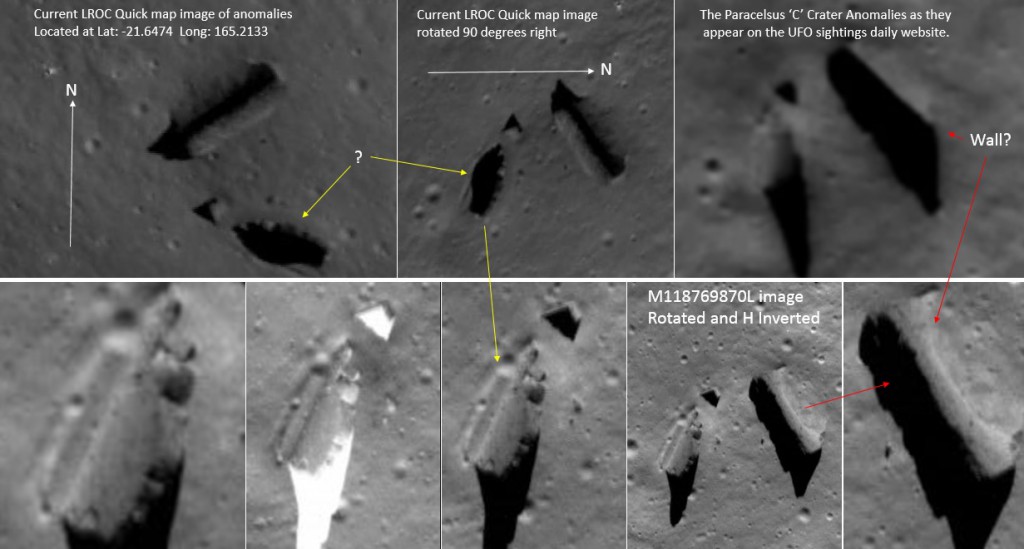 Figure 2 All of these images were supposed to be from the same area. They were allegedly from original NASA image sources, AS15-M-0083 (&84) and AS15-P-8868. They were distorted, rotated, H-inverted, and enlarged. It turns out that they are all one and the same targets seen under varying resolution. 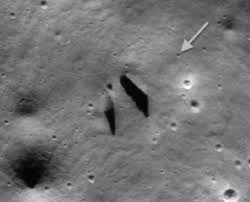 Figure 3.
Internet image showing "walls" or "towers" allegedly found on an Apollo 15 photo. According to the anomaly web sites, the Paracelsus Crater anomaly story was based on some other people's work, especially a fellow by the name of Scott Waring, and additional research and an accurate location was supplied by others, such as Lat: -21.6474 Long: 165.2133, which indicated to them an image from the Apollo 15 Panoramic Camera (AS15-P-8868), target being the crater Paracelsus. As you can see from the LROC image printscreen in Figure 1, the objects are very interesting for several reasons, and one of the first things needed was to find the same "structures" on other images. Out of many thousands of images taken of the Moon by the LRO, was this one from the lunar Far Side missed by NASA? 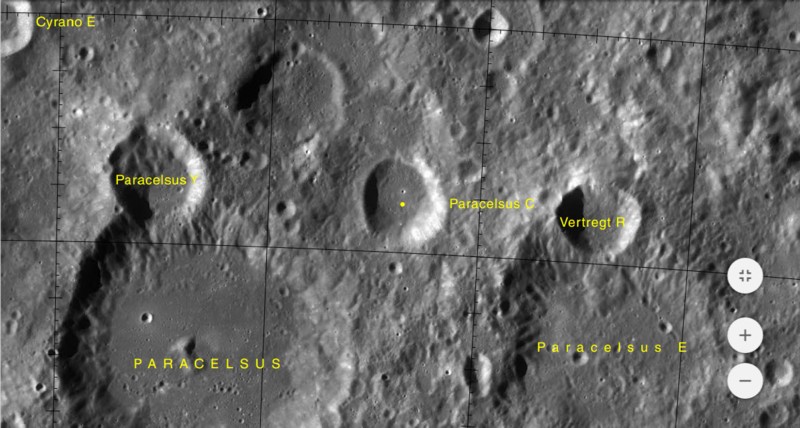 Figure 4
Cropped from LRO WAC Chart 103 In Figure 4
you can see the satellite crater, Paracelsus "C"
dead center. The primary crater Paracelsus is to
the left and "E" to the right. I was under the
mistaken impression at first that the
"structures" were in "C" and the "towers"
somewhere in the primary crater, a lot of
territory to cover.
APOLLO PANORAMIC CAMERAS 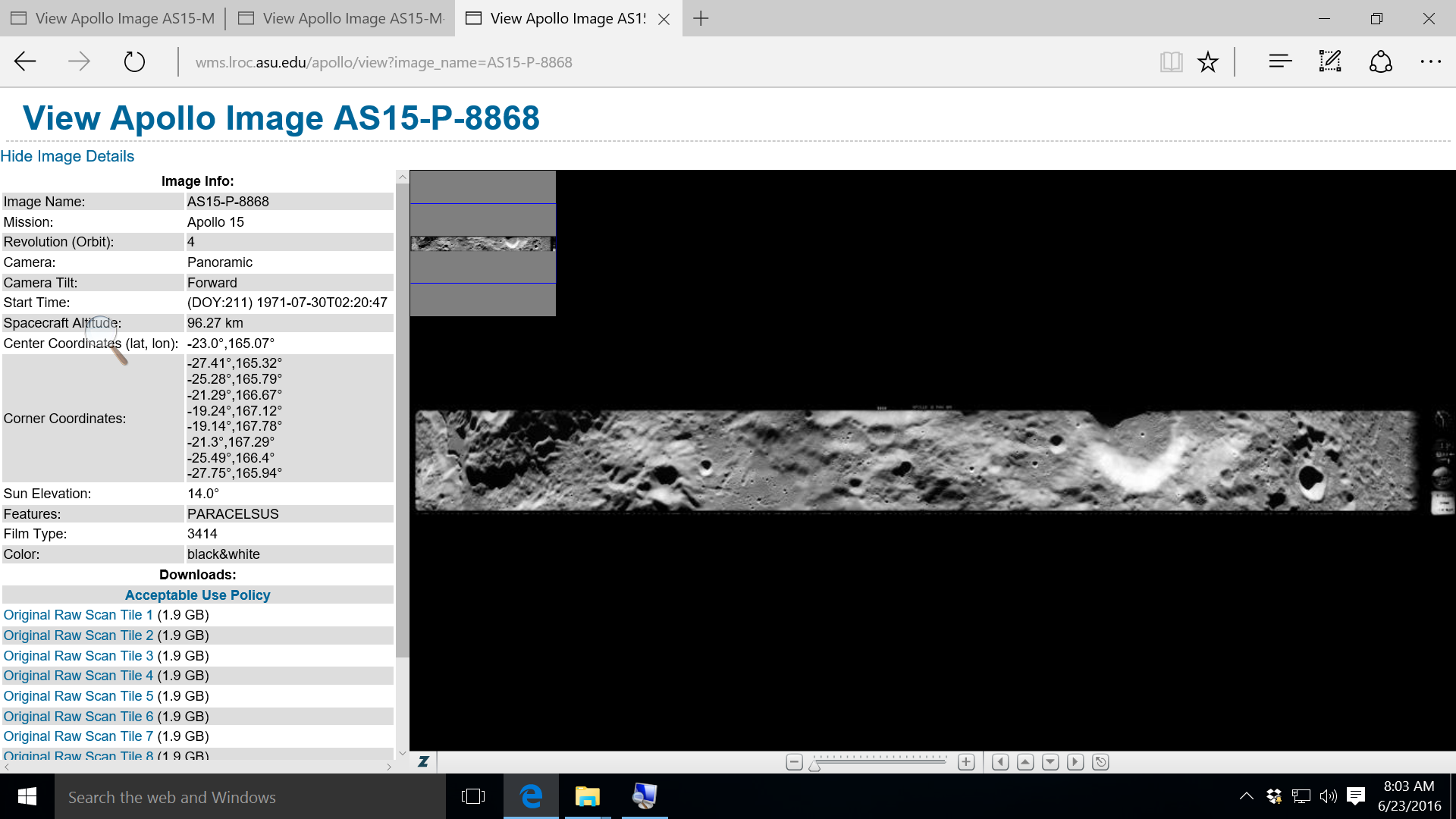 Figure 5.
printscreen of AS15-P-8868 S15-P-8868 Click here At 7 PM, on June 17th, I was able to locate the "twin towers" on an NASA Apollo Panoramic Camera image, AS15-P-8868. It is a slow and tedious job scanning the full frames of these images and I had to do it in-between my crowded work schedule and had just gotten to about the middle of LRS7 (Left-Right Scan segment 7) when "they" literally leaped out at me. I did a screen print (Figure 5). The support data for AS15-P-8868 states there were 8 tiles, so those tiles are larger than the 14 pc-screen-filled segments or strips I was scanning, and I re-estimated that the targets of interest probably resided in tile 3. Ananda Sirisena confirmed this and downloaded all 8 tiles in tif format. The Apollo 15 Panoramic Camera was in orbit around the Moon at 96 km altitude on July 30, 1971, and the sun elevation was 14.0 degrees. Within hours of my discovery, Ananda had found the same identical "towers" on an additional Apollo image, AS15-P-8873. This was a very important discovery. Now we had two different and very high resolution Apollo Panoramic Camera images of what we thought were "towers". The difference in viewing angles, as well as the sun elevation and the data from the shadows cast by these objects, would give us the opportunity and the ability to calculate the size and height of these very interesting features. What were once thought to be shadows in craters that were possibly photoshopped to get straighter edges and look artificial, turned out to be exactly what they appeared to be in the unredacted NASA Apollo images. And instead of shadows in craters, the objects appeared to be standing right in the middle of a flat area (exactly like the structures in the M frame of the other "structures" mentioned earlier) that resemble a wide shallow depression. In an attempt to predate the existence of the "structure" anomalies in 2010 we began looking at Apollo Panoramic and Metric images of the 1970's, in particular Apollo 15 which was actually July of 1971. With the target coords from LRO/ASU M118769870L being lat: lon: THE
APOLLO METRIC CAMERA
The Apollo Metric (mapping)
Camera obtained pictures of the surface covering
165 kilometers on a side, with a horizontal
resolution of 20 meters, based on a nominal
spacecraft altitude of 110 kilometers.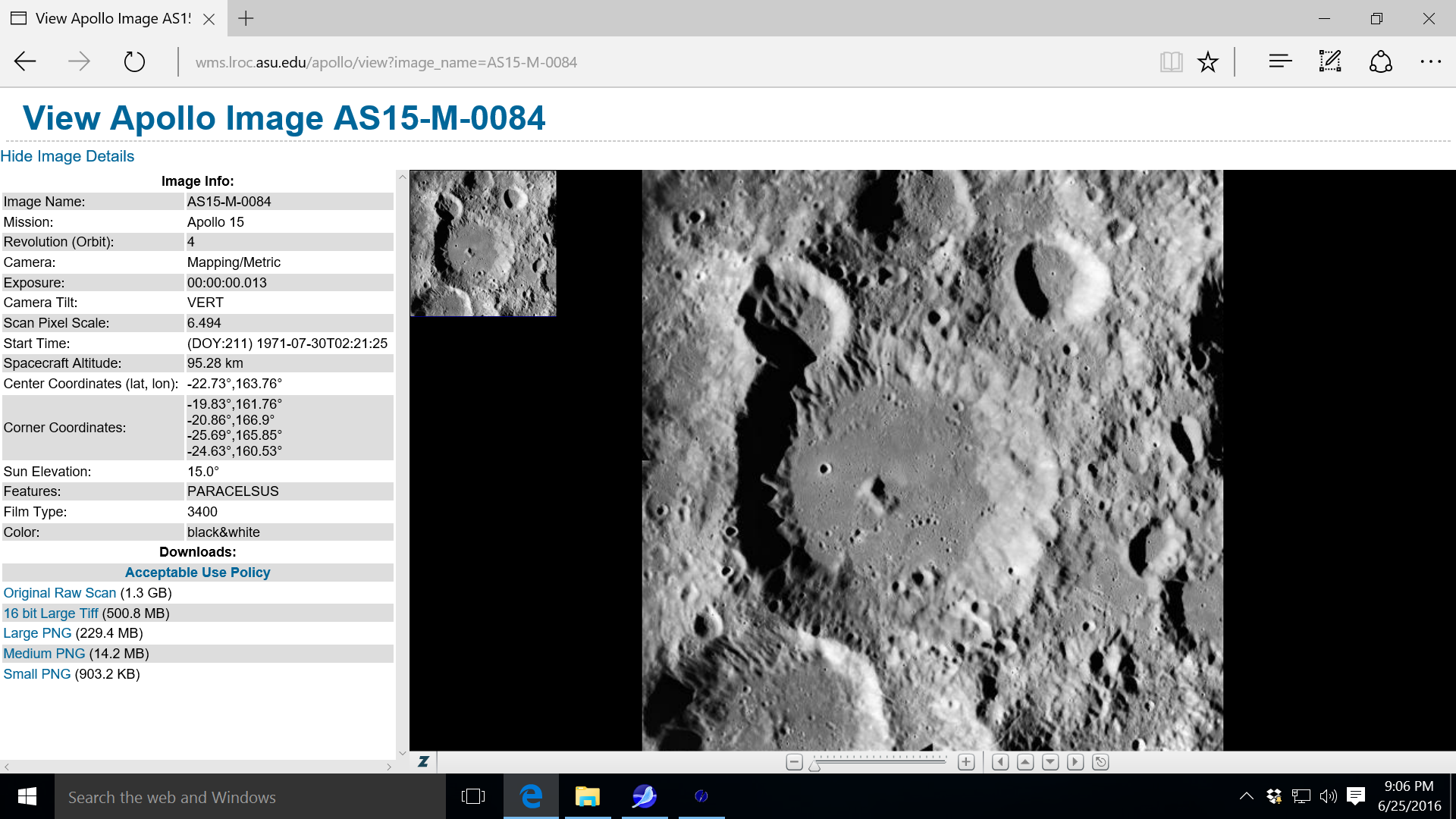 Figure 7 above shows the image taken by the Apollo 15 Metric Camera. There are actually two metric camera images of Paracelsus, one a slightly different view (frame 83) both showing a wider area of the target zone in 83-km wide crater Paracelsus (at 95 km up) on July of 1971. This one has Paracelsus more centered.
Figure 8. Eleven missions and mission dates
Figure 8
illustrates that we have to-date seven Apollo-15
images (*) and four LRO "M" frames (three of
which we are coming to). Mark Carlotto has
created two 3D "flyovers" of the targets and an
analysis provided later. Ananda Sirisena is
still searching for Clementine images (1994).
(* Three more Apollo Metric Camera images had been found containing the targets on June28th by Ananda Sirisena: AS15-M-0081, 0082, and 0085, naturally adjoining 0083 & 0084) 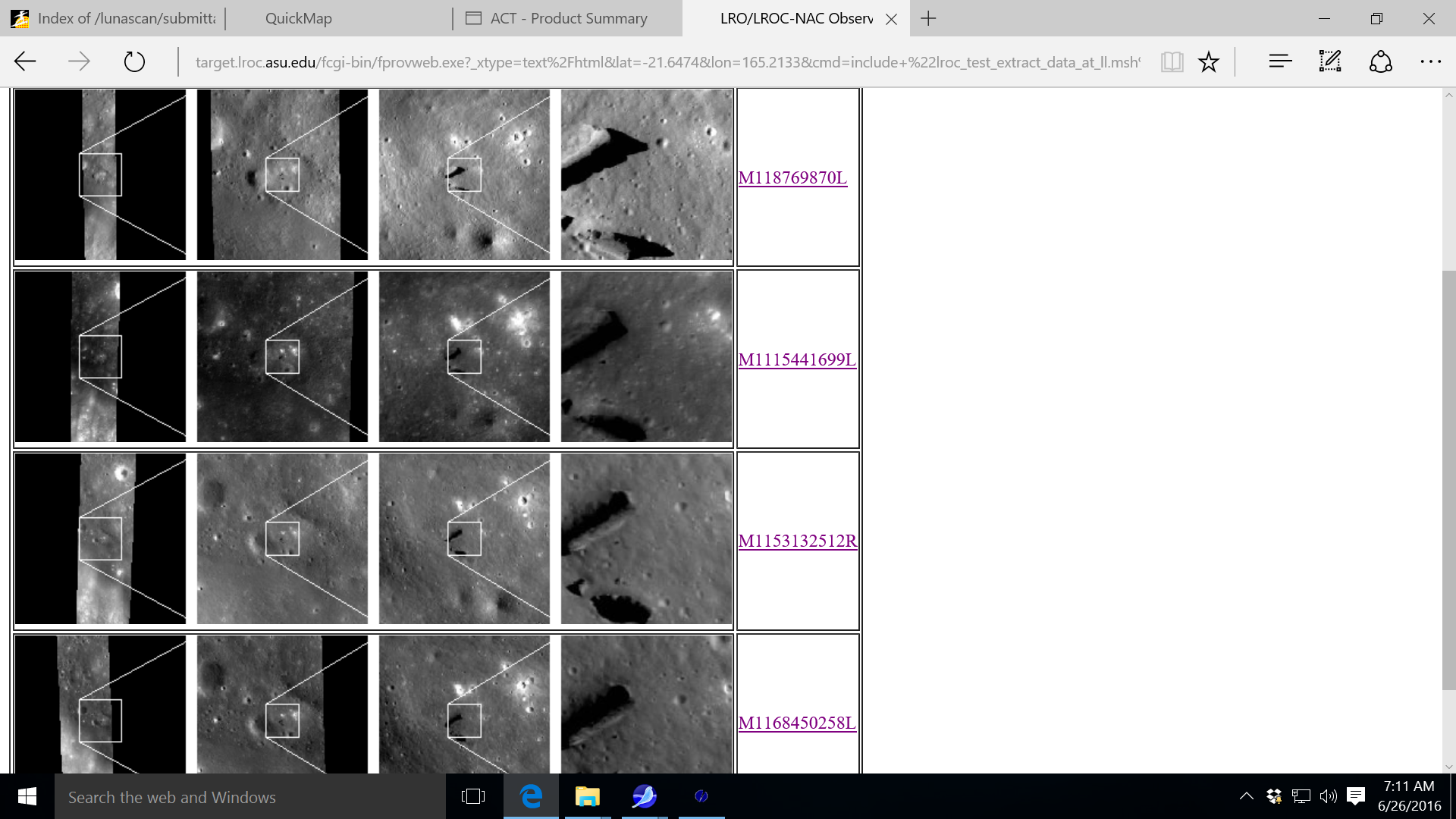 Figure 9. The Four LROC Images at Coords Ananda
& I both discovered three other LROC
frames which are graphically shown in
Figure 9, the ActReact QuickMap,
Projected NAC's at a given point. Lat
-21.649, Long 165.224 had the targets
but they were almost out of frame.
Lat-21.6474, Long 165.2133 were dead-on.
M118769870L is the same one shone above in Figure 1. To see any of these in full glory right at the NASA LROC site simply Google up the full M number and click on that Observation line. With those you can zoom in thanks to Adobe Flash. 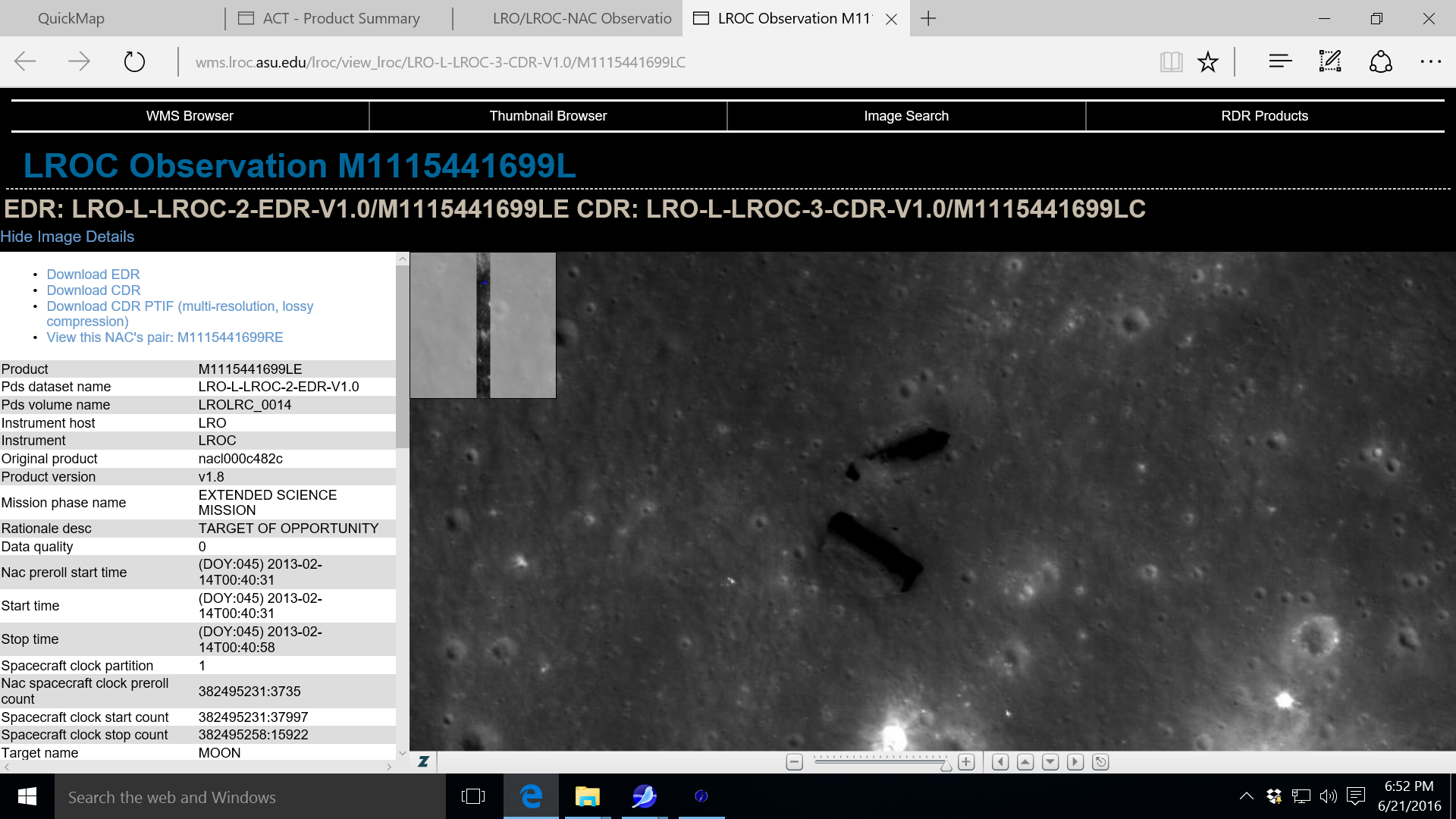 Figure 10 M1115441699L, taken on February 14. 2014, orbit 16613. 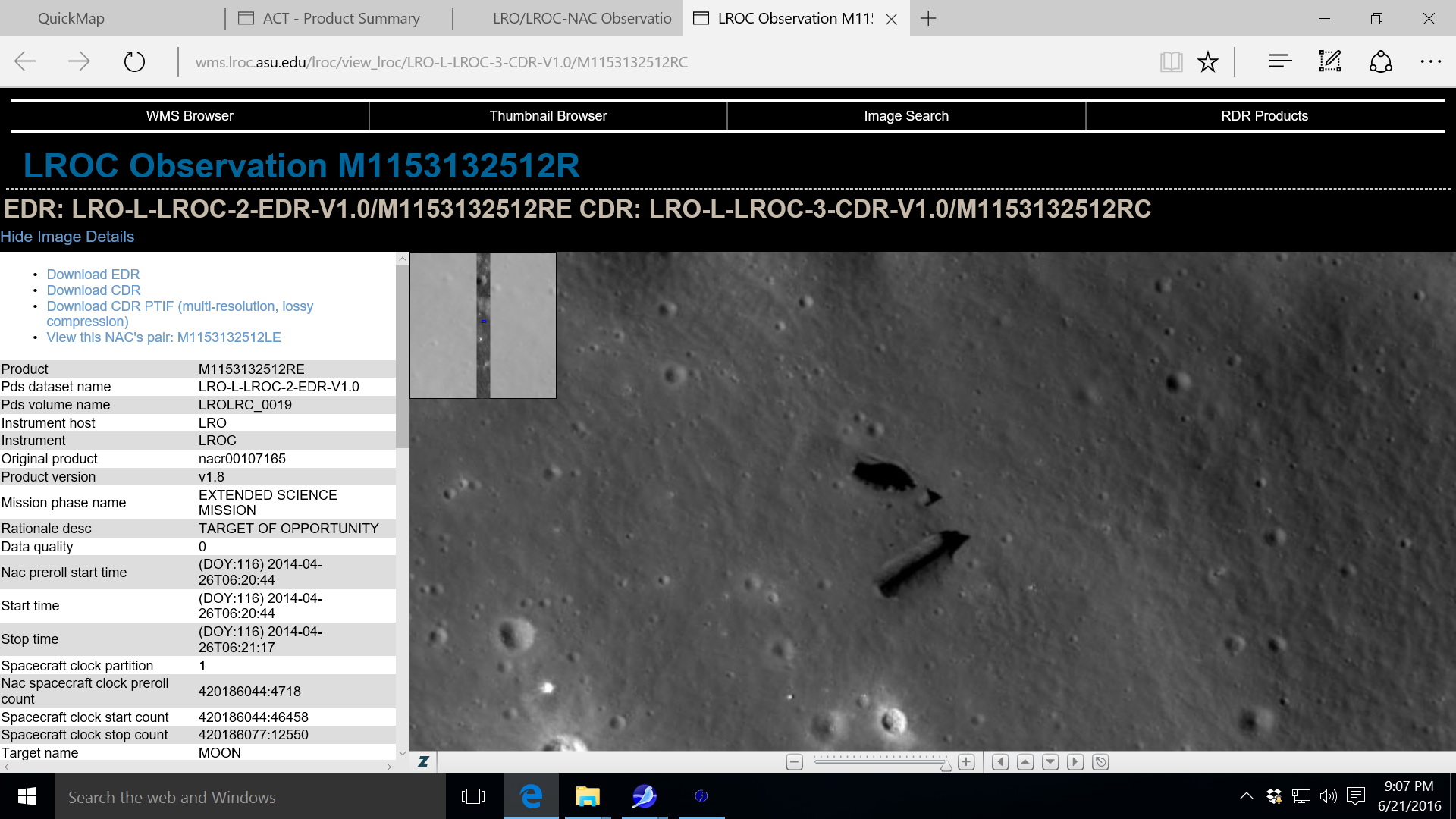 Figure 11 M1153132512R, taken April 25, 2014 on orbit 21914. 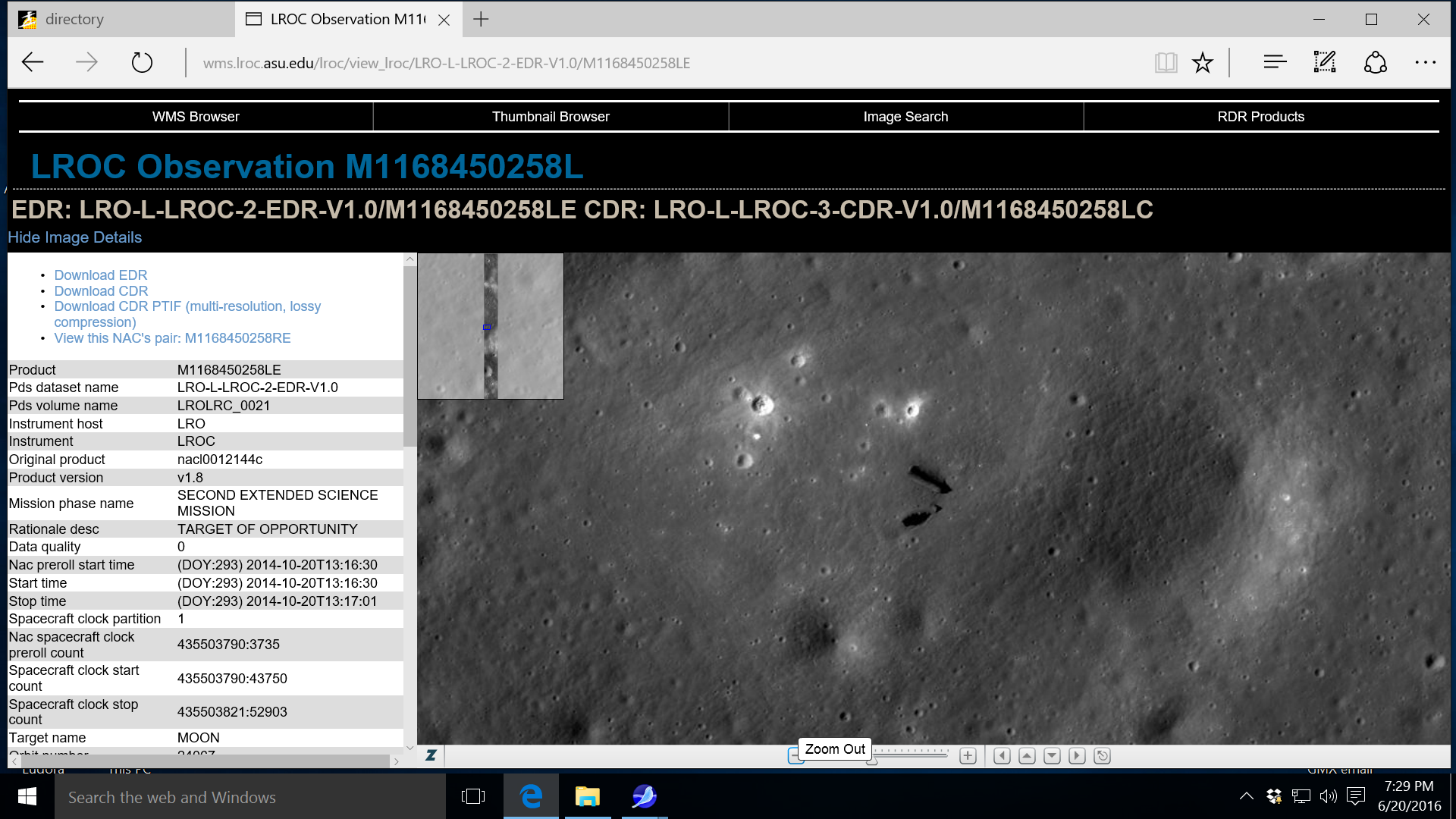 Figure 12 M1168450258L, taken Oct 20, 2014. SOME
COMMENTS REGARDING M118769870L
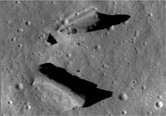 Be advised, the frame from LRO/ASU is actually upside down and South is at the top. The LROC (LRO Camera) was in a polar orbit and was coming over the pole heading south at the time of this imaging. Notice how the lunar regolith appears to have been ramped up against the bottom object (can't see the north side due to shadow), and also the smaller "ramped" area on the upper image. Dr. Mark Carlotto was one of the first consulted. He is a fellow member of SPSR and had helped us on the Blair Cuspid study in 1996. Carlotto: "Not towers, I agree. But they are interesting features. Great that you found them at LRO."However, Mark was unable to help us on the analysis at that time, but has since helped us file an analysis which is a separate report. Mike Swords popped the obvious question regarding this discovery. Swords: "So, just how big are the structures?"The first big lead in the analysis came from Brad Sparks. Sparks: 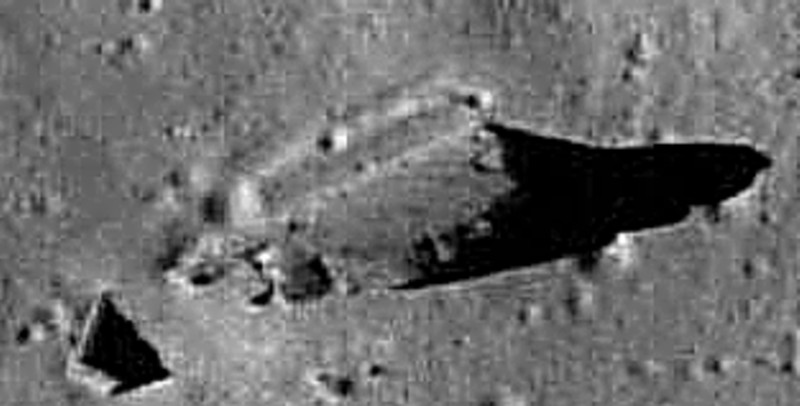 Figure
14. Enlargement of top object. Note
angled wall at bottom left (See
shadow).
These are not "walls" or "towers" of any kind. The consensus has been that "we don't know what they are, but we know what they are not." They have some height, this one estimated at 15 meters as the shadows clearly suggest, and the width and length (40 meters or 130') are of relatively good size as well. This is not any kind of a discarded launch vehicle, rocket stage, fuel tank, that had landed on the Far Side. There is not the slightest indication of an impact, no ejecta, etc., except the normal craters near the objects. The internet images of crashed or discarded space hardware all show bright splatter patterns. One comment not mentioned in this report, but had been brought up previously, was that the sun angles were problematic. "Dark shadows in the wrong direction" on the structures compared to the nearby craters. Analysis shows that all the shadows are correct. One must remember, this is not a retouched internet copy. This is an authentic image, right from LRO, handled, processed and cataloged by the contracted Arizona State University team. Mike Swords, still interested in the size of the objects, commented further. Swords: In
1996 David Williams helped us in our
re-discovery and confirmation of the
Blair Cuspids with his finding a
second Lunar Orbiter image overlapping
ours. I had to run this report by him
first before contacting anyone else in
NASA. His reply arrived on July 6th:
David Williams: 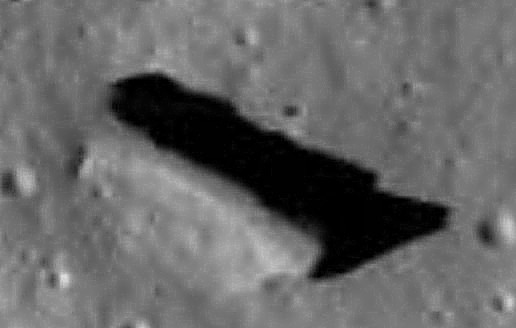 Figure
15.
This smaller object is longer than the upper "structure" and the shadows indicate it to be about 60 meters or 200' in length, with a height of about 15 meters. The structure seems to have been reinforced as if a bulldozer had shoved lunar regolith up against it. The crater to the left of the "ramp" seems to indicate that the structure was built before the crater was formed and this indicates the structure may be very, very old. This places the targets in Ridge Section 141, entitled "VanDeGraaf", on the lunar Far Side: http://www.lunascan.com/0141dir.htm 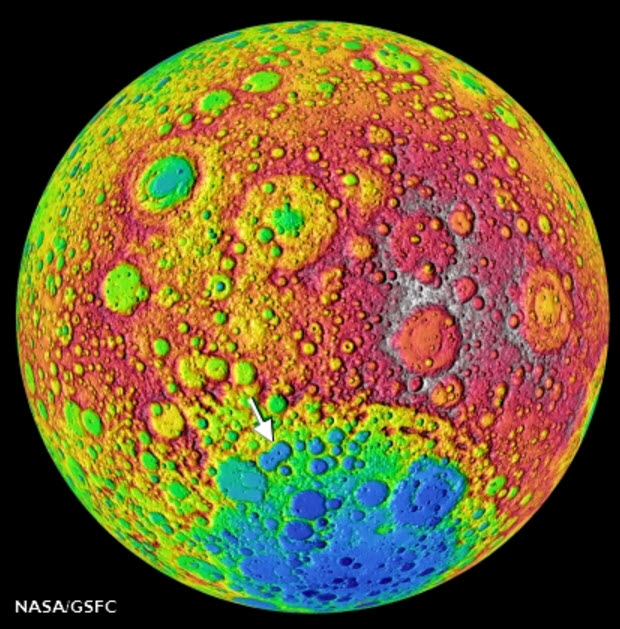 ..... .....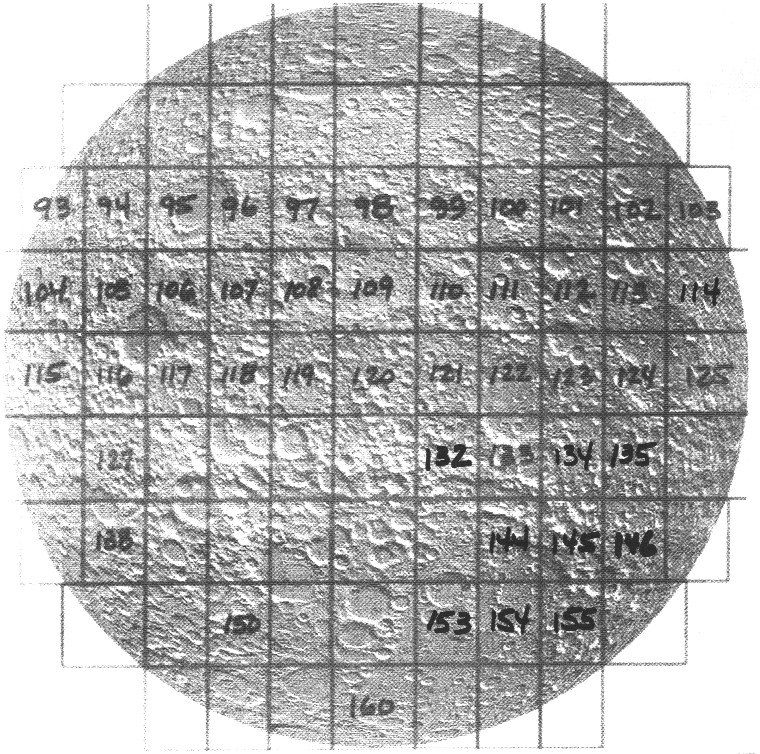 Figure 13 The
false-color map shows areas of
similar materials on the lunar Far
Side surface. The arrow marks the
location of the "structures" in
Paracelsus, which is NW of the
"figure 8" crater known as Van
DeGraaf, both of which lie within
the boundaries of Ridge Section 141.
Had I known about the anomalies in
2013 when I created the charts I
would have named Section 141,
Paracelsus, which resides in that
section.
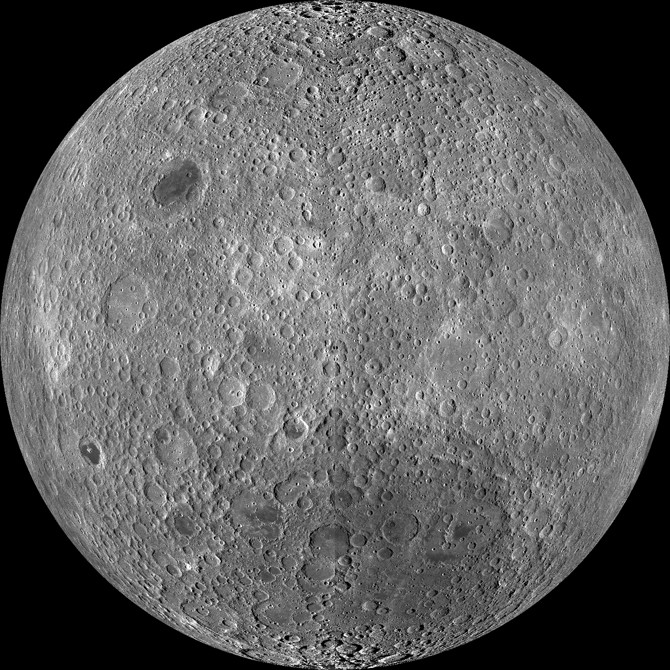 Figure
14. Lunar Far Side
This is a very high resolution LROC image of the full back side or Far Side of the Moon. The "figure 8" crater and the Paracelsus region can be easily be seen. Paul Davies of ASU wrote about footprints of alien technology and mentioned one type of search of particular interest here: Paul Davies, ASU: Fran Ridge: Ther crater Van de Graaff is near Paracelsus. The SW section has a central peak, while the NE floor is slightly smoother in form. Orbital studies of the Moon have demonstrated that there is a local magnetic field in the vicinity of this formation that is stronger than the natural lunar field. This is most likely an indication of volcanic rock underneath the surface. The crater also has a slightly higher concentration of radioactive materials than is typical for the lunar surface. I'm looking for such anomalies right in the area of the targets of interest, but so far haven't found any. 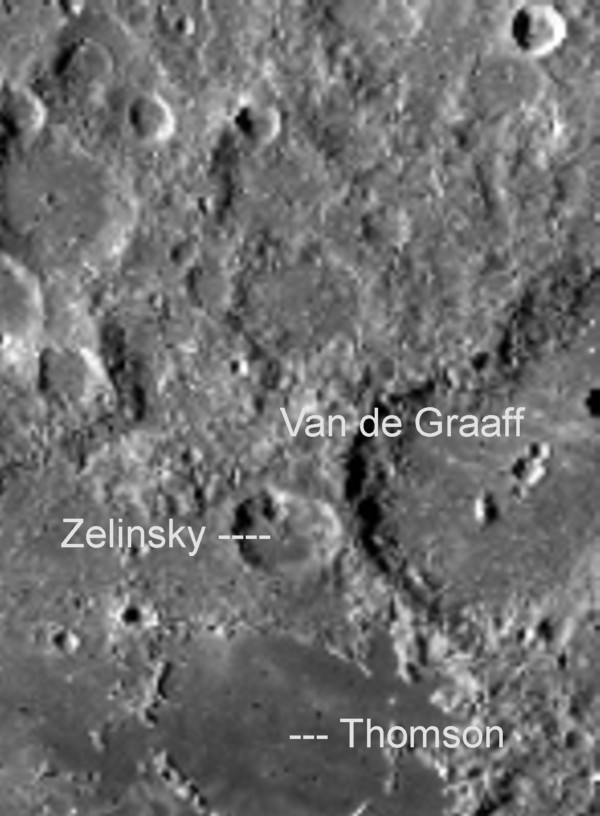 ... ...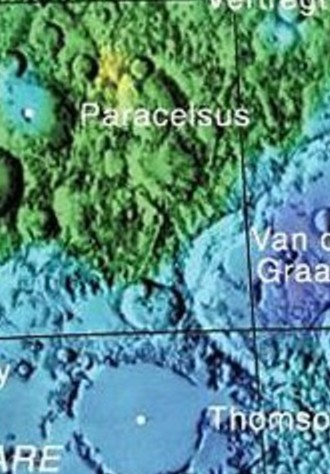 Figure 15 Ridge Section 141, VanDeGraaf Further confirmation of size and field came from Lunascan Project & SPSR member, Ananda Sirisena, who provided this: 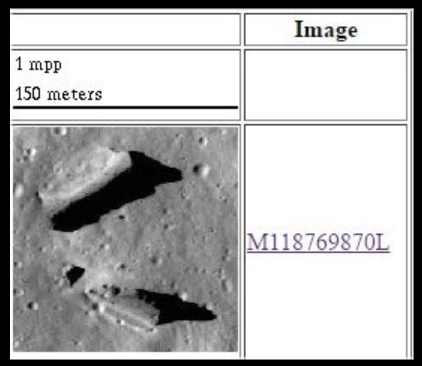 From
Projected NAC's at a given point
Fran Ridge, Coordinator, THE LUNASCAN PROJECT Coordinator, The Lunascan Project Member, Society for Planetary & SETI Research skyking42@gmx.com |